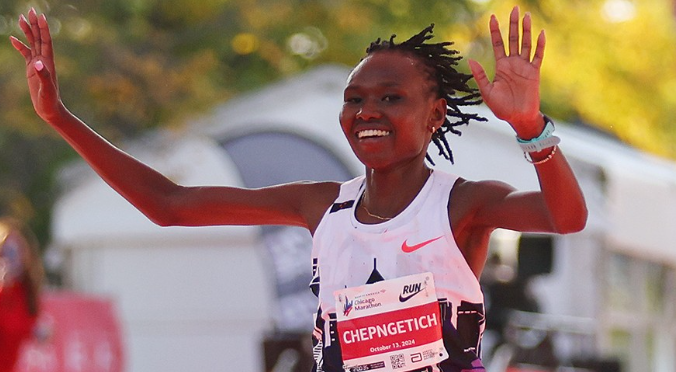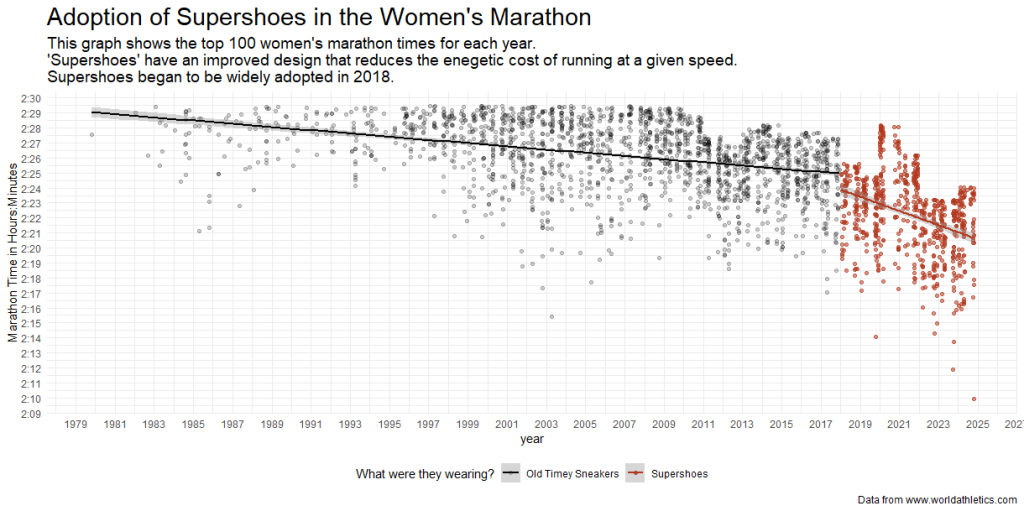
Supershoes and the Women’s Marathon
I used to be a running. I still am, but in a much more limited capacity. I still follow the sport though, and was surprised to see a MAMMOTH world record in the women’s marathon this past week by Ruth Chepgnetich.
I decided to revisit some analysis I did of top track times since the advent of supershoes. Here’s what I found, then I’ll explain supershoes below.

What are Supershoes?
Supershoes, a relatively recent innovation in running footwear, are characterized by their distinctive design: a stacked foam midsole and a carbon plate embedded within. This combination provides runners with a propulsive effect, enhancing their stride efficiency and speed.
How Do They Work?
- Stacked Foam Midsole: The thick, stacked foam midsole absorbs shock upon impact and provides a responsive bounce-back, propelling the runner forward.
- Carbon Plate: The carbon plate, strategically placed within the midsole, acts as a lever, storing and releasing energy during the push-off phase. This enhances propulsion and reduces energy loss.
Returning to the Analysis
A linear model on this data ndicated that runners wearing “Supershoes” have significantly faster marathon times compared to those in “Old Timey Sneakers.” On average, wearing Supershoes is associated with a 236.7-second (almost 4-minute) reduction in marathon time, and this effect is highly statistically significant (p < 2e-16).
Note: the model explains about 35% of the variation in marathon times (R² = 0.3461), meaning that while Supershoes play a noticeable role in faster times, other factors also influence performance. The residual standard error of 143.6 seconds suggests some variability in times that the model doesn’t account for.
Oh Yeah, Supershoes are Controversial
While supershoes have undoubtedly revolutionized running performance, their use has also sparked debates and controversies:
- Performance Advantage: Critics argue that supershoes provide an unfair advantage to elite runners, potentially widening the gap between professional and amateur athletes.
- Injury Risk: Some experts raise concerns about the potential for increased injury risk due to the altered biomechanics associated with supershoe use.
- Accessibility: The high cost of supershoes can limit their accessibility, creating a barrier for many runners.
The Future of Supershoes
Despite the controversies, supershoes are likely to remain a prominent feature in the world of running. As technology continues to advance, we can expect to see further innovations and refinements in supershoe design, potentially addressing some of the current concerns.
Explore and Learn with Science
Dive into groundbreaking research and inspiring stories with ‘This Week in Science’! Perfect for teachers and science enthusiasts, our free weekly newsletter expands your horizons in teaching and learning. Join us today and reshape your engagement with science. If you liked this blog, please share it! Your referrals help This Week in Science reach new readers.



